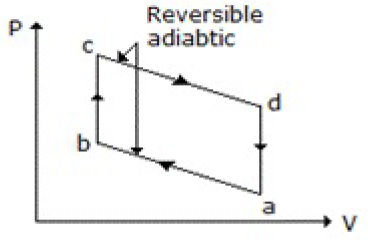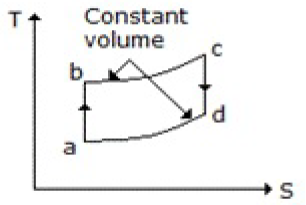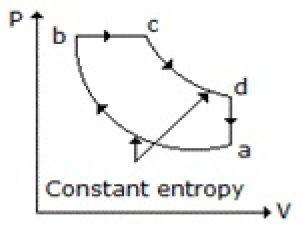__________ does not change during phase transformation processes like sublimation, melting & vaporisation.
Entropy
Gibbs free energy
Internal energy
All (A), (B) & (C)
Correct Answer :
B. Gibbs free energy
Related Questions
In case of a close thermodynamic system, there is __________ across the boundaries.
No heat and mass transfer
No mass transfer but heat transfer
Mass and energy transfer
None of these
Trouton's ratio of __________ liquids is calculated using Kistyakowsky equation.
Polar
Non-polar
Both (A) & (B)
Neither (A) nor (B)
Which of the following diagrams does not represent an Otto cycle?



None of these
Standard temperature and pressure (S.T.P.) is
0°C and 750 mm Hg
15°C and 750 mm Hg
0°C and 1 kgf/cm2
15°C and 1 kgf/cm2
Fugacity is most helpful in
Representing actual behaviour of real gases
Representing actual behaviour of ideal gases
The study of chemical equilibria involving gases at atmospheric pressure
None of these
The chemical potential of any constituent of an ideal solution depends on the __________ of the solution.
Temperature
Pressure
Composition
All (A), (B) and (C)
Gibbs-Duhem equation
States that n1dμ1 + n2dμ2 + ....njdμj = 0, for a system of definite composition at constant temperature and pressure
Applies only to binary systems
Finds no application in gas-liquid equilibria involved in distillation
None of these
The minimum number of phases that can exist in a system is
0
1
2
3
The unit of equilibrium constant of a chemical reaction is the same as that of
Molar concentration
Temperature
Internal energy
None of these
An ideal gas is taken around the cycle ABCA as shown in P-V diagram below: The work done by the gas during the cycle is equal to

12 P1V1
6 P1 V1
3 P1V1
P1 V1
Gibbs-Helmholtz equation is
ΔF = ΔH + T [∂(ΔF)/∂T]P
ΔF = ΔH - TΔT
d(E - TS) T, V < 0
dP/dT = ΔHvap/T.ΔVvap
Change of heat content when one mole of compound is burnt in oxygen at constant pressure is called the
Calorific value
Heat of reaction
Heat of combustion
Heat of formation
A gas shows deviation from ideal behaviour at
Low pressure and high temperature
Low pressure and low temperature
Low temperature and high pressure
High temperature and high pressure
Compound having large heat of formation is
More stable
Less stable
Not at all stable (like nascent O2)
Either more or less stable; depends on the compound
Pick out the wrong statement:
The expansion of a gas in vacuum is an irreversible process
An isometric process is a constant pressure process
Entropy change for a reversible adiabatic process is zero
Free energy change for a spontaneous process is negative
When a system is in equilibrium for all possible processes, the differential or finite change of entropy is
< 0
> 0
= 0
None of these
The standard Gibbs free energy change of a reaction depends on the equilibrium
Pressure
Temperature
Composition
All (A), (B) and (C)
Work done is a
Property of the system
Path function
Point function
State description of a system
Lowering of condenser temperature (keeping the evaporator temperature constant) in case of vapour compression refrigeration system results in
Increased COP
Same COP
Decreased COP
Increased or decreased COP; depending upon the type of refrigerant
Cp - Cv = R is valid for __________ gases.
Ideal
Very high pressure
Very low temperature
All of the above
With increase in pressure (above atmospheric pressure), the Cp of a gas
Increases
Decreases
Remains unchanged
First decreases and then increases
In a homogeneous solution, the activity coefficient of a component depends upon the
Pressure
Composition
Temperature
All (A), (B) and (C)
Measurement of thermodynamic property of temperature is facilitated by __________ law of thermodynamics.
1st
Zeroth
3rd
None of these
Degrees of freedom at triple point will be
0
1
2
3
Enthalpy changes over a constant pressure path are always zero for __________ gas.
Any
A perfect
An easily liquefiable
A real
If atmospheric temperature and dew point are nearly equal, then the relative humidity is
Zero
50%
Almost 100%
unpredictable
The shape of T-S diagram for Carnot Cycle is a
Rectangle
Rhombus
Trapezoid
Circle
The equation relating E, P, V and T which is true for all substances under all conditions is given by (∂E/∂V)T = T(∂P/∂T)H - P. This equation is called the
Maxwell's equation
Thermodynamic equation of state
Equation of state
Redlich-Kwong equation of state
The rate at which a substance reacts is proportional to its active mass and the rate of a chemical reaction is proportional to the product of active masses of the reacting substances. This is the
Lewis-Randall rule
Statement of Van't Hoff Equation
Le-Chatelier's principle
None of these
For water at 300°C, it has a vapour pressure 8592.7 kPa and fugacity 6738.9 kPa Under these conditions, one mole of water in liquid phase has a volume of 25.28 cm3 and that in vapour phase in 391.1 cm3.Fugacity of water (in kPa) at 9000 kPa will be
6738.9
6753.5
7058.3
9000
